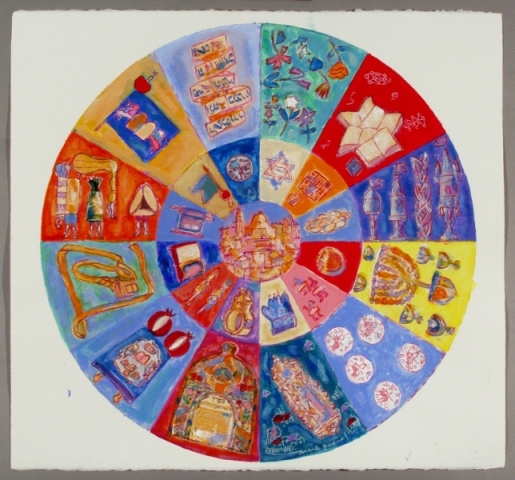With the High Holidays right around the corner, Calendars.com recently published a 2011 calendar, A Sweet Year, with paintings by Mark Podwal. I interviewed Marc Winkelman, president of Calendar Holdings LLC elsewhere; here, Podwal answers questions about his work.
 What was the timeline for the calendar project?
What was the timeline for the calendar project?
Two years ago, the Calendar Club distributed the second calendar I did for The Jewish Museum in Prague. Since they only publish a calendar every few years, Marc suggested around March or April that we do our own Jewish calendar. For The Jewish Museum in Prague calendars, almost all my paintings were based on Jewish Prague and almost all were created specially for each of the two calendars. Since there wasn't much time to design and print this calendar in time for this year's High Holidays, the paintings were selected from my previous works.
How did you select which images to include?
The majority of the images selected had never been previously published, although many had been exhibited at my Forum Gallery exhibitions. I tried to best match each image with a holiday in the month.
Do you see a logical or thematic progression in the works beyond the chronology of the calendar?
The only progression includes works with flowers for the spring months. I'm curious if you noticed a progression. Sometimes the observer has something interesting to point out that may have been unconsciously included by me. Cynthia Ozick once offered me a fascinating interpretation of one of my drawings for Elie Wiesel's book on the golem legend.
Did you have any idea that the paintings would end up in a calendar when you created them? Would you approach a painting differently if you knew it was going to be reproduced?
I had not foreseen that any of these works would appear in a calendar. Two are from my out-of-print book for Random House, A Sweet Year: A Taste of the Jewish Holidays. When I know a painting will be reproduced for a publication such as a book, periodical or calendar, I often make it less abstract in composition and not too esoteric. Not too esoteric does not mean that everyone will necessarily understand the image. My works often require some knowledge of the subject.
I can't help but notice that in October the order of the tribes (right to left) is: Reuben, Simeon, Levi, Judah, Issachar, Zebulen, Asher, Benjamin, Dan, Naftali, Asher, Josef? Can you clarify why you positioned them as such?
The order is based on the way the 12 stones of the twelve tribes appear on the breast plate of the High Priest based on a diagram in the Jewish Encyclopedia published in the early part of the 20th century. The colors of the flags of the tribes are based on the colors of the 12 stones, according to tradition, on the High Priest's breast plate. Although there were 12 stones, it is not described in the Bible or Talmud whether there were four rows of three stones from top to bottom, or three rows of fours stones top to bottom. The images on the flags are the traditional symbols of the tribes based on the Biblical blessings of Jacob and Moses. Of course, each Simhat Torah flag has an apple and candle, customary among East European Jewry.
What is the concept behind the winged Shabbat table?
The wings of the Shabbat table are based on the ministering angels and angels of peace in the song Shalom Aleikhem (Peace unto You). The song is based on an early Talmudic legend concerning two ministering angels (one bad and one good); these angels are said to accompany each Jew home from the synagogue on Friday evening, blessing or cursing his table depending upon whether he honors or dishonors the Sabbath.
Rabbi Yosi son of Rabbi Yehudah said: Two ministering angels accompany a person home on Friday night from the synagogue. One is an angel of good and one is an angel of evil. When the person arrives home to find that Shabbat candles lit, the table set and the beds made, the angel of good says, "May it be [Your] will that the next Shabbat should be the same." And against his will, the angel of evil answers, "Amen."
If not [meaning, if the candles are not lit and the table is not set], then the angel of evil says, "May it be [Your] will that the next Shabbat should be the same." And against his will, the angel of good answers, "Amen."
In his diaries, Kafka wrote that angels visit each Jewish home on Friday evening. However, Kafka adds that they do not stay too long. When I mentioned this amusing entry to Elie Wiesel, Elie told me that Kafka was right since according to the song Shalom Aleikhem the angels are welcomed and quickly said good-bye to.
Image: Jewish Life Cycle. Courtesy of Mark Podwal.